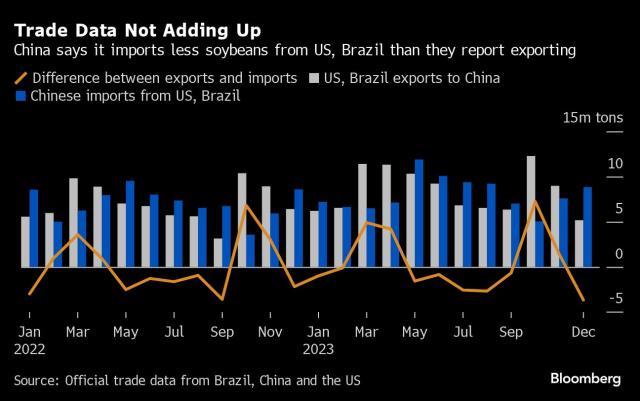Gap in China’s soybean trade casts doubt on data reliability
Doubts over the reliability of China’s economic figures are swirling again — this time in soybean trade as the world’s top importer has been publishing data that are increasingly diverging from other estimates.
Official data from China showed it imported more than 96 million tons of soybeans last year from Brazil and the US, the world’s biggest exporters. But data from those two nations show more than 101 million tons left their shores for China.
The difference is large enough for the US Department of Agriculture to stop using China’s data on soybean trade and rely on figures from exporting nations instead, it said this month.
Concerns about the quality of China’s economic data are hardly new, but they’ve increased as the country faces a slew of problems, including weak consumer confidence, plunging property sales and high youth unemployment. China imports more than 60% of the beans traded worldwide, so accurate data on how much it buys is critical for farmers around the world trying to plan crops.

“For about a year there have been issues with customs clearance of soybeans including more inspections of cargoes,” said Darin Friedrichs, co-founder and market research director of Sitonia Consulting, which focuses on Chinese agriculture. This “means the import data no longer matches up well with the export data after accounting for the time lag.”
“Previously, only a portion of cargoes would face heavy inspection, now this happening to nearly every cargo, which is causing delays,” he added.
The USDA boosted its forecasts for China’s soybean imports in the 2022-23 marketing year by 3.7 million tons to account for the discrepancy between major exporters’ shipments to China versus the country’s reported imports.
It also had to raise its estimates for Chinese imports for the current marketing year by 3 million tons to 105 million tons. For most countries including China, the USDA defines the marketing year as the 12-month period that runs from October.
The change was made after the authorities noticed the data diverging in 2023, according to a person with knowledge of the matter, who asked not to be identified discussing private matters. The change was previously reported by Reuters.
When asked about the divergent data on Tuesday, Wang Lingjun, vice minister at China’s General Administration of Customs, told reporters to refer to a previous response in October.
At that time, the spokesman for the customs agency said: “Theoretically, the statistics of China Customs and those of trading partners are mirror images of each other, but in fact they are not completely consistent due to various reasons, such as re-exports to third places.”
Earlier this month, China revised some soybean trade data to show it bought substantially less than was originally reported. The country had reported it bought 16 million tons in January-February 2023 for $10.8 billion, but later revised to say it bought just 14.3 million tons for $9.6 billion.
Import data for a broad range of products was also revised, slashing more than a billion dollars off the total value of Chinese imports in the first two months of 2023.
The data revision is part of efforts to provide more accurate data, Wang said on Tuesday. “Revision of trade data is a common practice for trade statistics in all countries including the US and sometimes the magnitude of their revision can be rather large,” he said at a briefing.
Similar Stories
United States and Norway issue innovative report creating greater transparency in critical mineral supply chains
Today, the U.S. Department of Commerce and the Norwegian Ministry of Trade, Industry, and Fisheries issued a thorough, innovative report presenting our shared understanding of non-market policies and practices (NMPPs)…
View ArticleDecember CNBC/NRF retail monitor results show strong growth boosted by final Thanksgiving weekend days
Retail sales jumped strongly in December, boosted in part by two busy holiday shopping days during Thanksgiving weekend falling in the final month of the year, according to the CNBC/NRF…
View ArticleNAW presents Dirk Van Dongen Lifetime Achievement Award to Bergman, CEO of Henry Schein, Inc.
At the 2025 NAW Executive Summit Gala on January 28 in Washington, D.C.
View Article
St. Louis region’s chemical industry welcomes new investment
View Article
Navigating compliance: Adapting to changing Customs regulations in global supply chains
View Article
December 2024 U.S. Transportation Sector Unemployment (4.3%) Was the Same As the December 2023 Level (4.3%) And Above the Pre-Pandemic December 2019 Level (2.8%)
View ArticleGet the most up-to-date trending news!
SubscribeIndustry updates and weekly newsletter direct to your inbox!





